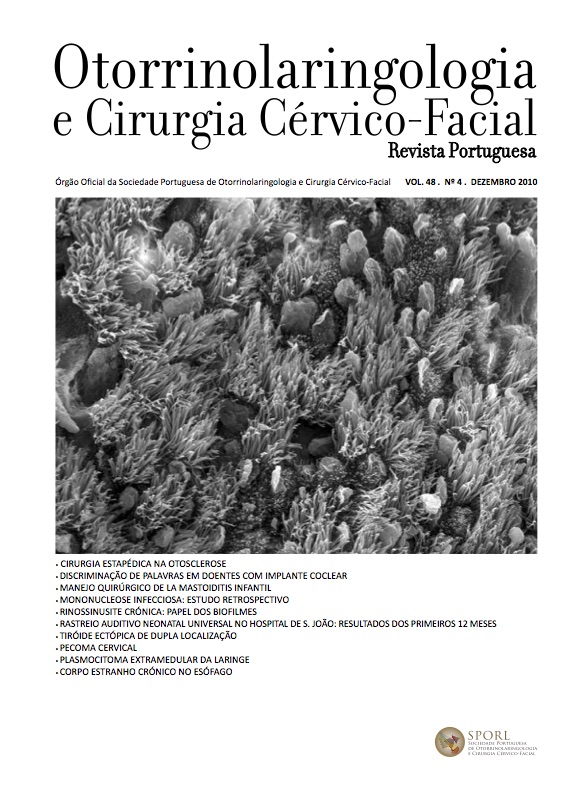Universal newborn hearing screening at S. João Hospital: first 12 months results
DOI:
https://doi.org/10.34631/sporl.213Keywords:
deafness, neonatal hearing screening, newborn, otoacoustic emissions, brainstem evoked auditory potentialAbstract
Objectives: Hearing loss is one of the most common congenital anomalies. Its detection and early intervention are crucial to the appropriate verbal, cognitive, behavioural and cognitive development. This study aimed to evaluate the neonatal hearing screening preformed at the Hospital S. João in the first 12 months since its implementation.
Study Design: Retrospective study
Material and Methods: Newborns infants admitted in the Well baby and Neonatal Intensive Care Unit (NICU) submitted to audiometric evaluation by otoacoustic emissions complemented, whenever necessary, by brainstem auditory evoked potentials.
Results: The global coverage in the Maternity was 96% (2373) newborns from the initial population. One hundred and eight cases were lost. Three newborns presented with unilateral deafness and none had bilateral deafness. In the NICU, 175 (83%) newborns were evaluated. Five were diagnosed with bilateral deafness and one unilateral.
Conclusions: Neonatal hearing screening in all newborns, healthy or with risk factors is critical in early detection of hearing anomalies and the subsequent intervention.
Downloads
References
Declau F, Boudewyns A, van den Ende J, Peeters A, et al. Etiologic and audiologic evaluations after universal hearing screening: analysis
of 170 referred neonates. Pediatrics 2008;121:1119-26
Kaye CI; Committee on Genetics. Newborn screening fact sheets. Pediatrics 2006;118:e934-63
Van Straaten HL, Tibosch CH, Dorrepaal C, Dekker FW, et al. Efficacy of automated auditory brainstem response hearing screening in very
preterm newborns. J Pediatr 2001;138:674-8
Hensch TK. Critical period regulation. Annu Rev Neurosci 2004;27:549-79
Gilley PM, Sharma A, Dorman MF. Cortical reorganization in children with cochlear implants. Brain Res 2008;1239:56-65
Kral A, Hartmann R, Tillein J, Heid S et al. Hearing after congenital deafness: central auditory plasticity and sensory deprivation. Cereb
Cortex 2002;12:797-807
Thompson DC, McPhillips H, Davis RL, Lieu TL, et al. Universal newborn hearing screening: summary of evidence. JAMA 2001;286:2000-10
Yoshinaga-Itano C, Sedey AL, Coulter DK, Mehl AL. Language of early and later identified children with hearing loss. Pediatrics
;102:1161-71
Lim G, Fortaleza K. Overcoming challenges in newborn hearing screening. J Perinatol 2000;20:S138-42
Yoshinaga-Itano C. Early intervention after universal neonatal hearing screening impact on outcomes. Ment Retard Dev Disabil Res
Rev 2003;9:252-66
Davis A, Bamford J, Wilson I, Ramkalawan T, et al. A critical review of the role of neonatal hearing screening in the detection
of congenital hearing impairment. Hearing Technology Assessment 1997;1:1–105
Morton C, Nance WE. Newborn Hearing Screening-A silent revolution. N Engl J Med 2006;354:2151-64
Grupo de Rastreio e Intervenção da Surdez Infantil. Recomendações para o Rastreio Auditivo Neonatal Universal (RANU).
Acta Pediatr Port 2007;38:209-14
American Academy Of Pediatrics: Task Force on Newborn and Infant Hearing. Newborn and Infant Hearing Loss: Detection and
Intervention. Pediatrics 1999;103:527-30
Kirkim G, Serbettcioglu B, Erdag TK, Ceryan K. The frequency of auditory neuropathy detected by universal newborn hearing
screening program. Int J Pediatr Otorhinolaryngol 2008;72:1461-9
Foerst A, Beutner d, Lang-Roth R, Huttenbrink KB, et al. Prevalence of auditory neuropathy/sinaptopathy in a population of children with
profound hearing loss. Int J Pediatr Otorhinolaryngol 2006;70:1415-22
Sanes DH, Bao S. Tuning up the developing auditory CNS. Curr Opin Neurobiol 2009;19:188-99
Calonge N, Petitti DB, DeWitt TG, Gordis L, et al. Universal screening for hearing loss in newborns: US Preventive Services Task
Force recommendation statement. Pediatrics 2008;122:143-8
Jakubíková J, Kabátová Z, Pavlovcinová G, Profant M. Newborn hearing screening and strategy for early detection of hearing loss in
infants. Int J Pediatr Otorhinolaryngol 2009;73:607-12
Olusanya BO. Follow-up default in a hospital-based universal newborn hearing screening programme in a low-income country.
Child Care Health Dev 2009;35:190-8
Mukari SZ, Tan KY, Abdullah A. A pilot project on hospital-based universal newborn hearing screening: lessons learned. Int J Pediatr
Otorhinolaryngol 2006;70:843-51
American Academy of Pediatrics. Year 2007 Position Statement: Principles an Guidelines for early hearing detection and intervention
programs. Pediatrics 2007;120:898-921
Ribeiro A, Falcão A, Guimarães H. Spratley J, et al. Rastreio auditivo por otoemissões acústicas em recém-nascidos de risco. Abstract, VI
Congresso Português de Pediatria – Santa Maria da Feira, 17-19 Maio de 2001






